Circinus constellation is located in the southern sky. Its name means “the compass” in Latin, referring to the tool for drawing circles.
Circinus was created and first catalogued by the French astronomer Nicolas Louis de Lacaille in the 18th century. Lacaille created the constellation to bridge the void between Triangulum Australe and the stars marking Centaurus‘s forefeet.
Circinus contains several notable deep sky objects, including the Circinus Galaxy, the X-ray source Circinus X-1, the pulsar PSR B1509-58, the open clusters NGC 5823 and NGC 5715, and the planetary nebula NGC 5315.
Facts, location and map
Circinus is the fourth smallest constellation in the sky, 85th in size, occupying an area of only 93 square degrees. It lies in the third quadrant of the southern hemisphere (SQ3) and can be seen at latitudes between +30° and -90°. The neighboring constellations are Apus, Centaurus, Lupus, Musca, Norma, and Triangulum Australe.
The constellation name Circinus is pronounced /ˈsɜːrsɪnəs/. In English, the constellation is known as the Compass. The genitive form of Circinus, used in star names, is Circini (pronunciation: /ˈsɜːrsɪnaɪ/). The three-letter abbreviation, adopted by the International Astronomical Union (IAU) in 1922, is Cir.
Circinus does not have any stars brighter than magnitude 3.00 or located within 10 parsecs (32.6 light years) of Earth. The brightest star in the constellation is Alpha Circini, which is also the nearest star in Circinus, located at a distance of 53.50 light years from Earth.
Circinus belongs to the Lacaille family of constellations, along with Antlia, Caelum, Fornax, Horologium, Mensa, Microscopium, Norma, Octans, Pictor, Reticulum, Sculptor, and Telescopium.
Circinus has two stars with known exoplanets, HD 134060 (spectral class G0VFe+0.4) and HD 129445 (G6V). HD 134060 has two planets in its orbit, both discovered in 2011, and HD 129445 has one, a Jupiter-like planet discovered in 2010. Circinus does not contain any Messier objects. It is associated with a meteor shower that peaks on June 4, the Alpha Circinids (ACI), first observed in 1977.
The constellation does not contain any formally named stars.
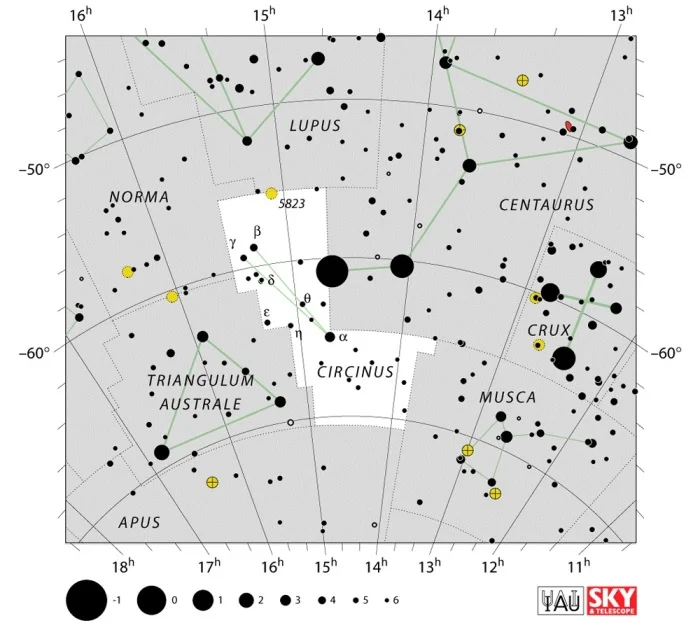
Circinus constellation map by IAU and Sky&Telescope magazine
Story
There are no myths associated with Circinus. The constellation was named after the drafting tool used for drawing circles (not after a mariner’s compass, which is represented by the constellation Pyxis).
It is depicted as a pair of dividing compasses used by draughtsmen to measure distances.
Lacaille originally named the constellation le Compas and placed it next to Triangulum Australe, which he depicted as a surveyor’s level, to fill the void between several existing constellations in the south.
Circinus stars
α Circini (Alpha Circini)
Alpha Circini is the brightest star in the constellation, with an apparent magnitude of 3.19. It is a visual binary, with a faint companion. It is classified as a variable star, belonging to the class of rapidly oscillating Ap stars. It lies about 53.5 light years from Earth.
β Circini (Beta Circini)
Beta Circini is the second brightest star in Circinus, with an apparent magnitude of 4.069. It is a main sequence star belonging to the spectral class A3Va. It is approximately 97 light years distant.
γ Circini (Gamma Circini)
Gamma Circini is another binary star in the constellation. It is composed of a pair of blue and yellow stars.
HD 129445
HD 129445 is a star belonging to the spectral class G6V, notable for having a planet in its orbit. The planet was named HD 129445 b. Its existence was confirmed by 17 Doppler velocity tests conducted as part of the Magellan Planet Search Program. The star has an apparent magnitude of 8.8 and is 220 light years distant.
Deep sky objects in Circinus
Circinus Galaxy
The Circinus Galaxy is a spiral galaxy approximately 13 million light years distant. The galaxy is notable for the motions of gas that form two rings inside it. One of the rings is a site of massive star forming activity.
The galaxy was discovered in 1975. It is an active galaxy with a black hole-powered core.
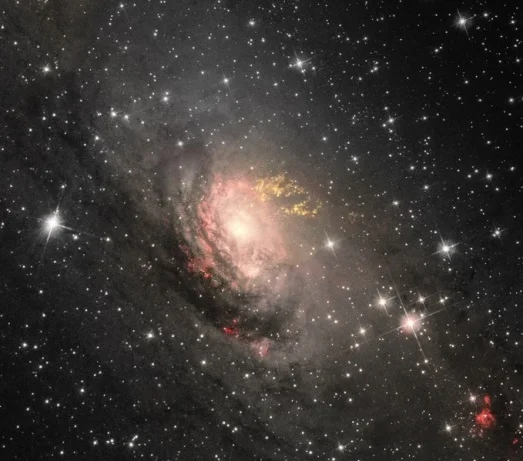
Circinus Galaxy (ESO 97-G13), image: Judy Schmidt (CC BY 2.0)
Circinus X-1
Circinus X-1 is an X-ray double star composed of a neutron star and a main sequence star, with the former orbiting the latter. The system is located approximately 30,700 light years away. The X-ray source was discovered on June 14, 1969, during a scan of the region of the sky occupied by the constellations Circinus, Norma and Lupus.
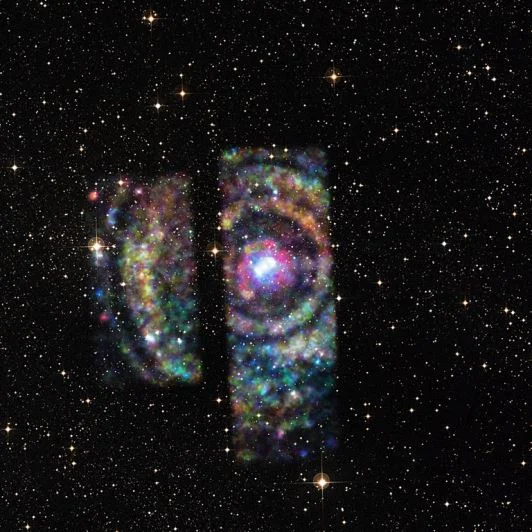
Astronomers using NASA’s Chandra X-ray Observatory have discovered the largest and brightest set of rings from X-ray light echoes ever observed. These extraordinary rings, produced by an intense flare from a neutron star, providing astronomers a rare chance to determine how far it is from Earth. The rings appear as circles around Circinus X-1, a double star system in the plane of the Milky Way containing a neutron star, the dense remnant of a massive star pulverized in a supernova event. The neutron star is in orbit with another massive star, and is shrouded by thick clouds of interstellar gas and dust. Circinus X-1 is also the source of a surprisingly powerful jet of high-energy particles. “It’s really hard to get accurate distance measurements in astronomy and we only have a handful of methods,” said Sebastian Heinz of the University of Wisconsin in Madison, who led the study. “But just as bats use sonar to triangulate their location, we can use the X-rays from Circinus X-1 to figure out exactly where it is.” The light echo shows that Circinus X-1 is located about 30,700 light years from Earth, and settles the difference in results published in prior studies. The detection and characterization of the rings required the unique capabilities of Chandra — the ability to detect fine details combined with sensitivity to faint signals. Researchers determined that the rings are echoes from a burst of X-rays emitted by Circinus X-1 in late 2013. The burst reflected off intervening clouds of dust, with some reflected X-rays arriving to Earth from different angles at a time delay of about one to three months, creating the observed rings. By comparing the Chandra data to prior images of dust clouds detected by the Mopra radio telescope in Australia, the researchers determined that each ring was created by the X-ray reflections off a different dust cloud. The radio data provides the distance to the different clouds and the X-ray echo determines the location of Circinus X-1 relative to the clouds. An analysis of the rings with the combined radio data allows researchers to use simple geometry to accurately determine the distance of Circinus X-1 from Earth. Image – X-ray: NASA/CXC/Univ. of Wisconsin-Madison/S. Heinz, et al.; Optical: DSS
NGC 5315
NGC 5315 is a bright planetary nebula in Circinus. Like all other planetary nebulae, it was created when a star in the final stages of its life shed its outer layers and cast them off into space.
The nebula is located 5.2 degrees west-southwest of the star Alpha Circini. It has an apparent magnitude of 9.8. The nebula’s central star has a magnitude of 14.2.
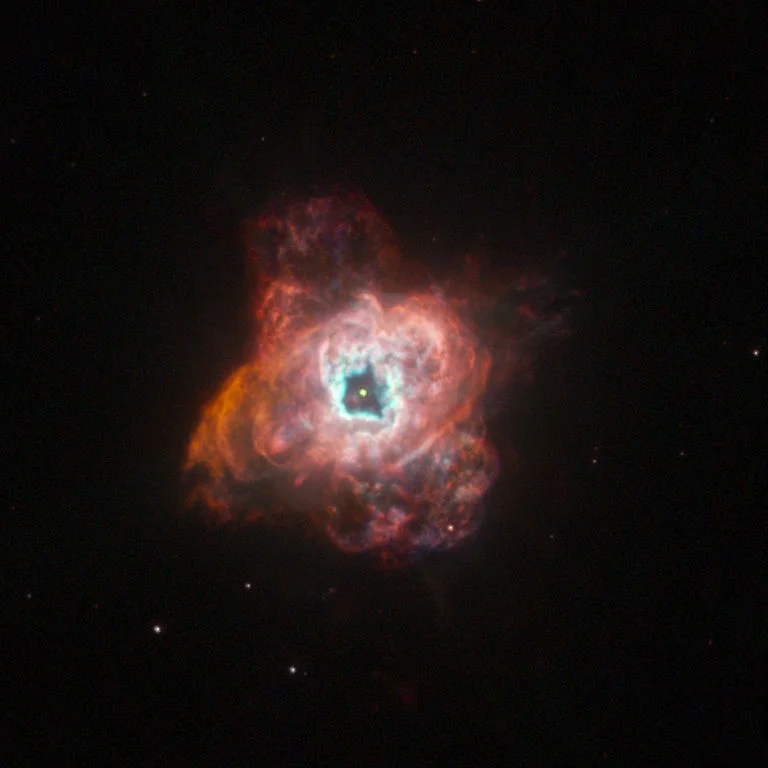
NGC 5315, image: NASA, ESA, and the Hubble Heritage Team (STScI/AURA)
NGC 5823
NGC 5823 (Caldwell 88) is an open cluster in Circinus, located on the border with the constellation Lupus. The cluster is about 800 million years old. It has an apparent magnitude of 7.9 and lies at a distance of 3,500 light years from Earth.
NGC 5823 was discovered by the Scottish astronomer James Dunlop in 1826. It spans about 12 light years.
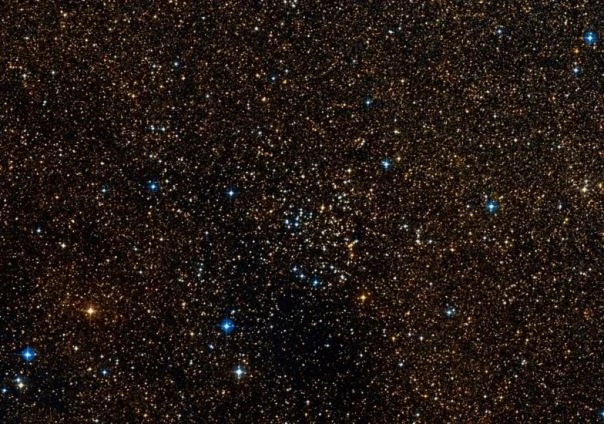
NGC 5823, image: Wikisky
NGC 5715
NGC 5715 is another open cluster in Circinus. It has a visual magnitude of 9.8 and is considerably smaller than NGC 5823. The cluster occupies an area 7 arc minutes in size and contains only 30 stars.
Pismis 20
Pismis 20 is an open cluster that contains only 12 stars. It has an apparent size of only 4.5 arc seconds but, at magnitude 7.8, is almost as bright as NGC 5823. Pismis 20 lies at a distance of 8,270 light years from Earth.
PSR B1509-58 (Hand of God)
PSR B1509-58 is a pulsar located about 17,000 light years from Earth. It is embedded in a nebula about 150 light years across. It is believed to be about 1,700 years old.
The pulsar is emitting energy into the surrounding nebula, creating intricate shapes and structures. One of these looks like a large hand and has earned the nebula the name Hand of God.
PSR B1509-58 has a spin rate of almost 7 times per second. It was first detected by the Einstein X-Ray Observatory in 1982. The observatory was NASA’s first fully imaging X-ray telescope to be launched into space.
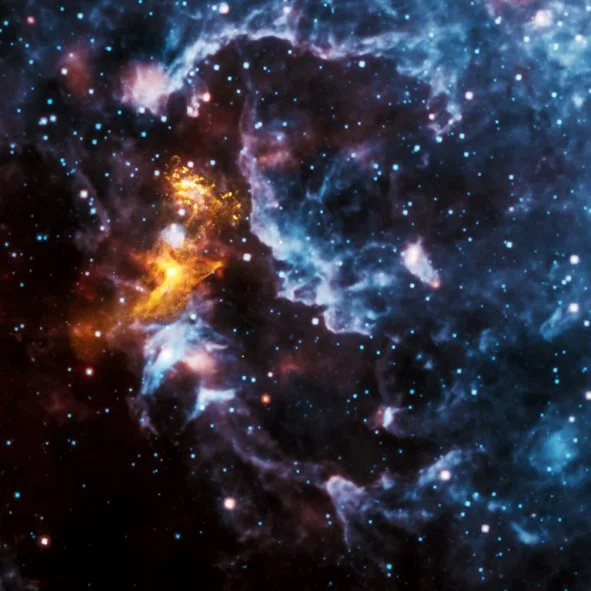
Pareidolia is the psychological phenomenon where people see recognizable shapes in clouds, rock formations, or otherwise unrelated objects or data. There are many examples of this phenomenon on Earth and in space. When an image from NASA’s Chandra X-ray Observatory of PSR B1509-58 — a spinning neutron star surrounded by a cloud of energetic particles –was released in 2009, it quickly gained attention because many saw a hand-like structure in the X-ray emission. In a new image of the system, X-rays from Chandra in gold are seen along with infrared data from NASA’s Wide-field Infrared Survey Explorer (WISE) telescope in red, green and blue. Pareidolia may strike again as some people report seeing a shape of a face in WISE’s infrared data. What do you see? NASA’s Nuclear Spectroscopic Telescope Array, or NuSTAR, also took a picture of the neutron star nebula in 2014, using higher-energy X-rays than Chandra. PSR B1509-58 is about 17,000 light-years from Earth. Image: NASA/CXC/SAO (X-Ray); NASA/JPL-Caltech (Infrared)